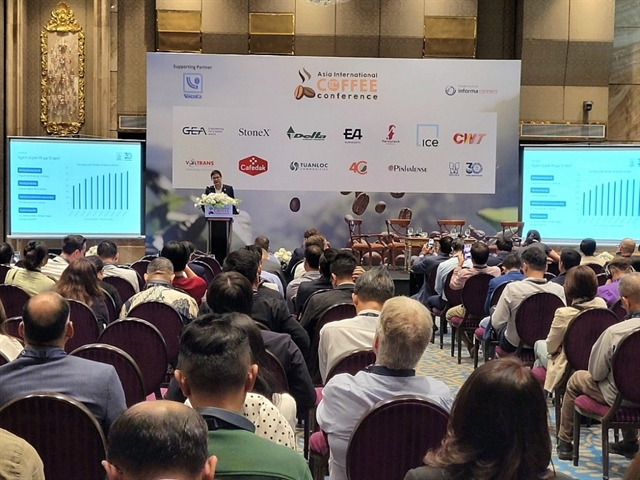
|
| More than local and international organisations and businesses attended the 27th Asia International Conference in HCM City on December 5 and 6. — Photo Nguyễn Hiền |
HCM CITY — Việt Nam’s coffee export volume in the 2023-24 season is likely to be lower than a year earlier due to a drop in output, no carry-over stock and growing local demand, and export prices will remain high, according to the Việt Nam Coffee and Cocoa Association.
Speaking at the 27th Asia International Conference in HCM City on December 5 and 6, Nguyễn Nam Hải, the association’s chairman, said Việt Nam, the world’s largest robusta coffee supplier, is in the 2023-24 harvest season, with about 50 per cent of total cultivation areas harvested, with output estimated to drop much more than expected.
He said the new season is likely to yield 1.6-1.7 million tonnes compared to 1.78 million tonnes in the previous season due to unfavourable weather and shrinking planting area.
Việt Nam’s coffee export volume in the first 11 months of 2023 decreased by nearly 13 per cent over the same period in 2022 and is likely to fall by almost 15 per cent for the whole year, he added.
Đỗ Hà Nam, the association’s deputy chairman and chairman of Intimex Group, one of Việt Nam’s leading coffee export companies, said coffee cultivation areas, especially in Đắk Lắk and Đắk Nông, are shrinking.
He elaborated that each hectare of coffee brings in a profit of about VNĐ200 million ($8,211), while avocado offers VNĐ1-1.5 billion, more than five times compared to that of coffee. Therefore, it is tough to keep farmers engaged in coffee farming.
According to data from the Ministry of Agriculture and Rural Development, the country has about 700,000ha under coffee cultivation, but in reality, it may only be over 600,000ha, he said.
Steve Wateridge, head of research at Tropical Research Services, said the global coffee supply had seen quite a sizable deficit in the past two years, significantly impacting stockpiles and prices.
He said that global consumption of robusta beans rose by 10 per cent in 2023, whereas Arabica production fell by 8 per cent, adding that higher demand has pushed up robusta beans’ prices.
Nam said 2023 is quite a particular year for Việt Nam’s coffee industry when domestic and export prices continuously increase. In particular, there was a time when the domestic coffee price went up to VNĐ70,000 per kilo, the highest price in many years.
Nam added that right at the beginning of the 2023-24 crop year, the price of coffee beans in the domestic market was very high, about VNĐ60,000 per kilo. Such a high price at the beginning of the crop is also something that has never happened in the history of the Vietnamese coffee industry.
In 2023, there was almost no coffee from farmers for businesses to buy from June, he said, adding that, but for 2024, there may be a shortage of local supply stock from May and even from April.
Demand for Việt Nam’s robusta coffee from Europe is expected to stay strong until April 24 before Indonesia and Brazil enter the new crop season from April to March and from July to June, respectively.
In addition, domestic coffee consumption will continue increasing, up to 350,000 tonnes of green beans from the current 260,000 tonnes if all soluble plants reach full capacity.
“With lower output, depleted stock, and an increase in coffee consumption in the domestic market, Việt Nam is likely to export 1.4 million tonnes of coffee in the 2023-24 crop, lower than that in the 2022-23 crop,” Nam said, adding that “the price of robusta beans will continue to increase at least to next April before Indonesia and Brazil enter the new season.”
At the conference, domestic and international experts also spoke about growing coffee sustainably, moving towards deforestation-free coffee production, building sustainable supply chains, and making the coffee sector ready for EU Deforestation-free Regulation (EUDR) and others.
Hải said in the context of global coffee production trending downward, the development of the global coffee industry must be associated with green growth.
From the beginning of the 2023-24 crop year, the coffee industry must have an action plan to adapt to the EUDR, the EU’s Carbon Border Adjustment Mechanism, and others. The step-by-step implementation of these programmes demonstrates the global coffee industry’s responsibility to protect the environment and minimise climate change’s impact, he added.
Vanúsia Nogueira, Executive Director of the International Coffee Organization, said Vietnamese coffee producers need to follow all these sustainable regulations because this is starting from Europe, but probably the other countries will follow.
“I think the producers here in Việt Nam are already following this. What they need to do is find better ways to show the market that they are following all the requirements for sustainable development,” she said. — VNS
- Reduce Hair Loss with PURA D’OR Gold Label Shampoo
- Castor Oil Has Made a “Huge” Difference With Hair and Brow Growth
- Excessive hair loss in men: Signs of illness that cannot be subjective
- Dịch Vụ SEO Website ở Los Angeles, CA: đưa trang web doanh nghiệp bạn lên top Google
- Nails Salon Sierra Madre
 VnExpress News The News Gateway of Vietnam
VnExpress News The News Gateway of Vietnam





